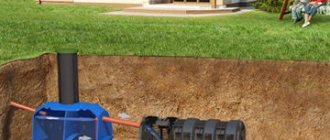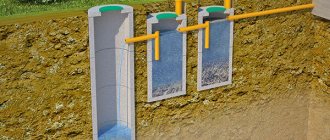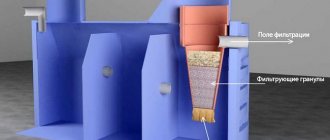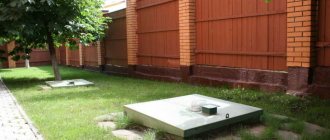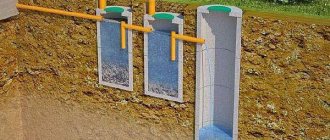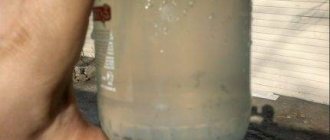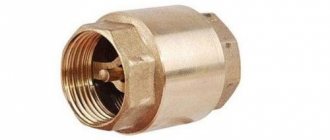Septic tanks for toilets, depending on the principle of operation, come in three types of designs: a sealed tank, a septic tank with filtration fields, and a biological treatment station. When choosing a septic tank, you need to pay attention to the following factors: level of water consumption, geology of the site, financial resources allocated for construction.
The use of sewer water treatment devices in a country house becomes consciously necessary, since dirty water immediately returns to the person who drained it, causing considerable harm.
Wanting to reduce cleaning costs, many residents of country houses install systems that operate on the principle of a septic tank without pumping.
In addition to reducing waste disposal costs, such devices make it possible to ensure a degree of water purification at the outlet of up to 98%. We suggest that you familiarize yourself with information on how to choose a septic tank for your dacha.
What types of septic tanks are there?
A septic tank is a system of containers whose task is to collect and treat household wastewater. There are several types - models that require regular cleaning and those that do not.
Accumulating septic tanks
Accumulators are an analogue of a cesspool. From time to time it is necessary to invite a vacuum cleaner to pump out the contents from the container.
Storage tank BARS-N Source santorpack.ru
Special septic tanks
Special septic tanks, in which cleaning is carried out by bacteria that process the contents. There are several types of microorganisms for which such food is considered ideal. They feel great in a prepared environment and work to purify wastewater. This is an expensive pleasure. Since special containers with bacteria are purchased in stores.
Scheme of operation of a special septic tank BARS-Bio Source sharanavti.ru
Septic tanks without pumping
The third option is septic tanks without pumping. This is a system of 2-3 containers dug into the ground. Budget and most affordable option.
Sectional view of a septic tank without pumping BARS-Aero Source erkas.ru
What does the sewer system consist of?
An autonomous waste disposal system involves the construction of a septic tank. Before you start designing communications, it is worth understanding what the pumping mechanism consists of. A typical home cleaning system includes:
- storage tanks that are connected using pipes. The containers consist of 2 or 3 chambers. The first tank, the sump, should be filled ¾, and the second - ½.;
- ventilation shafts made in each of the containers;
- sealed hatches.
All components of septic networks ensure complete elimination of odors and effective disposal of sewage.
The principle of operation of a septic tank without pumping
Wastewater treatment in such a system occurs due to water settling. The best option is 3 containers into which liquid waste is gradually supplied. The tanks are buried in the ground and connected at the top by a pipe. From each there is an outlet for air intake.
Plastic septic tank made of 3 containers of different volumes Source kzs-septik.ru
Domestic wastewater from the house is washed into the first container, and the bulk of the heavy mass settles at the bottom. When the liquid level reaches the pipe connecting the first tank to the second, the water flows into another container. This is a purer substance, but still requires purification. The liquid settles and the masses settle to the bottom. When the water level reaches the connecting pipe, it spontaneously flows into the third tank. This is a vessel with a filtration system at the bottom. Water enters the ground through the filtration purification pad. This is wastewater that has already been treated three times.
There are designs consisting of 2 chambers, but such cleansing is not effective enough.
Let's consider the design of the device
The construction of external sewerage has the sole purpose of getting rid of human waste products. But before doing this, it is necessary to ensure the safety of the wastewater so as not to pollute the water that has yet to be used.
Traditionally, cesspools were used for this purpose to accumulate waste. Depending on the intensity of use, such devices require regular pumping of the contents; according to SanPin standards, such an event should be performed at least once every six months or when full.
Watch the video - operating principle, diagrams and experience of using sewerage without pumping
SEPTIC - PRINCIPLE OF OPERATION, DIAGRAM, EXPERIENCE OF USE. Sewerage without pumping. High groundwater
In some cases, the regularity of such an operation occurs within a month or two, and its cost ranges from 12,000 rubles.
The main components of a storage tank with pumping are:
- A durable sealed housing capable of holding contents without penetrating into the ground outside the cesspool. To do this, you need to thoroughly waterproof it.
- Natural tank ventilation system. When storing fecal waste, methane gas is formed, which in a certain proportion with air is a flammable or explosive mixture that must be regularly released from the chamber.
- Double cap on the neck. Internal wooden and external metal or plastic.
- A drain pipe through which wastewater flows from the internal sewer system to the external one.
The principle of constructing a septic tank without pumping is somewhat more complicated, since the processes occurring in wastewater during its processing are important.
Therefore, the main components of such devices are:
- Drain pipe between the exit from the building and the storage tank of the external sewerage system. Its diameter should be 100-110 millimeters, length at least 10 meters. For financial and technological reasons, plastic products are usually used.
- Next comes the storage tank, which performs several functions. The first is crushing the drain stream, for which a baffle plate is used, which directs the stream down and crushes it. In this case, heavy inclusions settle to the bottom, where they are processed by aerobic bacteria.
- When the liquid level rises to the overflow pipe, it begins to flow into the second container. An air atomizer and a low-power compressor for pumping atomized air are installed in it.
The sufficiency of oxygen in wastewater triggers the work of aerobic bacteria, which additionally process organic matter in the liquid being purified, bringing its degree of purification to 98-99%.
Further, various devices can be used in the form of chlorine cartridges, UV emitters, additional filters for final cleaning and disinfection of the drain.
Advantages of septic tanks without pumping
An important advantage of such a device is the absence of the inherent odor of waste water. Equally important is the significant savings in money - septic tanks for dachas without pumping do not need to be connected to the sewer system, which is an expensive and troublesome task. In addition, many models do not require an electrical connection.
In addition, the entire system is completely located in the ground and does not pollute the environment, so supervisory authorities do not make claims against such areas.
If we consider a drainage pit, it only accumulates contaminated wastewater, which is absorbed by the soil. In such a situation, the soil around the “storage” becomes saturated with untreated liquid masses, which greatly disturbs the environment. If you add to this a specific smell, the picture turns out to be completely unsightly.
A septic tank is fundamentally different from the old form of waste accumulation. This is an isolated system of containers, hermetically sealed, completely preventing the entry of untreated waste into the soil. Sealing the chambers provides odor protection. The presence of a septic tank on the site can be guessed by the ventilation pipes.
An important advantage of a septic tank without pumping is complete sealing Source proagregat.com
Requirements of the domestic SNiP for sewerage installations
The main regulatory document that is used to guide the construction of communications without pumping is SNiP 2.04.03-85. Here are the basic legal requirements for private or summer cottage areas where it is planned to install a septic tank:
- For installation, pipeline networks from the same material are selected.
- When laying pipes, check their tightness. The main line is connected to the riser using a cross or tee.
- In dacha areas, a non-pressure system with a slope of pipes with a diameter of 110 mm by 20 mm is relevant.
- The hidden type of installation provides an open connection to the home riser.
- Communications are located at a distance of 5-15 m from a residential building. Long main lines lead to pipe clogging.
- The septic tank is located 50 m from the water source. However, it is necessary to take into account the water permeability of the soil - on sandy soils, septic tanks are removed at a distance of more than 50 m.
- The sewerage system is not located on the border with the neighboring territory; more than 1 m is set back from the fence.
Septic systems are not installed in areas with large vegetation, the roots of which harm the tightness of the tanks.
Choosing the size of the septic tank
An important point that determines how efficiently the entire system will work is the volume of the septic tank. It all depends on the amount of wastewater. The more water a family consumes, the larger the wastewater tank is chosen. When calculating the size of the chamber, we proceed from the norm of water consumption per person – 200 liters. That is, the volume of the septic tank = the number of family members x 200 liters.
For a family of 2 people, 2 cleaning chambers are enough. The planned laundry, showers, and other expenses are taken into account. If there is a large amount of water consumed, it is necessary to install 3 purification chambers.
Rules for digging a pit
Measures for the construction of sewer lines without the possibility of pumping involve digging holes into which reinforced concrete rings are inserted.
There are several rules for digging a pit:
- If the soil waters are close, the trench is deepened by 1.5-2 m. If the waters are deep, a hole dug 1 m is sufficient.
- Concrete rings should be placed tightly in the sump trench. There should be a cavity of no more than 5 mm between the wall of the product and the soil.
- The bottom of the pit is made with a slope of 25-30 degrees. The tilt must be done in the direction where the hatch is planned to be placed. This will ensure that solid sediment remains on the surface of the tank.
- A network of perfectly level trenches is drawn to the cesspool pit. This prevents large waste from settling on the walls.
- In relief areas, it is necessary to maintain the angle of inclination of the highway - about 45 degrees.
After the pit has been dug, it is advisable to make formwork.
Don't forget about drainage and filtration fields
Masters offer 2 post-treatment systems - drainage or filtration systems.
The drainage (filtration) well is the last chamber in the cleaning system. Often it is a simple well without a bottom. Wastewater treatment is carried out by gradual seepage of water through the ground, so it is important that groundwater is no closer than 2.5 m to the surface. Sand or crushed stone is poured onto the bottom, which becomes a filter pad. The technique is used when groundwater is deep.
This is what a septic tank drainage system looks like when it reaches the ground surface Source tupikov.ru
Important! Several drainage wells are built on clay soils. This is a cheaper option compared to a filtration field.
The filtration field is the pipes through which water passes to be completely purified. They occupy a larger area than a drainage well. With a large amount of water consumed, it can occupy an area of several tens of m². This option is suitable for close groundwater, it is labor-intensive and expensive. Before constructing a field, it is necessary to correctly calculate its dimensions. To install a septic tank for a dacha without electricity, the following are taken into account:
- number of water consumers;
- soil composition;
- diameter of pipes supplying wastewater;
- average annual air temperature.
To enhance the cleaning effect, a layer of sand or crushed stone is poured at the lower level of the field, having previously separated it from the soil with a special filtration fabric.
Project activities
Country communications for waste disposal require proper design. You need to start with calculating the volume of the septic tank, then draw up a diagram and carry out preparatory insulation.
How to calculate sewer volume?
Two factors are taken into account - groundwater level and the average level of ground freezing. In addition to external factors, the construction of communications takes into account the features of buildings:
- the presence of household appliances, the intensity of their operating mode;
- frequency of use of the house and the entire site;
- number of people who reside permanently;
- complexity of plumbing systems.
In buildings that are used year-round, one resident consumes approximately 200 liters of water. The septic tank removes wastewater in 3 days, so to calculate its volume, the formula is used: Y x 200 l x 3 days = V, where Y is the number of residents, and V is the volume of containers.
Drafting
When designing communications, their type is taken into account - reinforced concrete containers on formwork, installation of ready-made reinforced concrete forms, construction of a brick tank or installation of plastic chambers. The best option for self-construction is sewerage without pumping based on concrete products. It is characterized by speed and simplicity of arrangement.
The need for thermal insulation
For a stable cleaning process, regardless of weather conditions, it is important to maintain an optimal temperature. The close location of groundwater makes it impossible to deepen the reservoirs. For this purpose, experts recommend thermally insulating the structure. The materials used are foam chips, expanded clay or polyurethane foam.
Laying internal lines
According to the communication layout diagram, the installation of the pipeline begins. First, the central riser with a diameter of 110 mm is fastened. Gases are removed through chimney ducts. Work with pipes made of several materials:
- PVC products are resistant to chemical components and do not rust. Plaque rarely forms on them, and thanks to the smooth inner surface, wastewater is removed efficiently. The line is secured using the socket method.
- Cast iron systems are more expensive than plastic ones, but the costs are justified by their reliability and durability. Pipes are difficult to install by one person, so work with an assistant.
- Ceramic elements are made from clay and then fired. The wear resistance of sewer networks and heat resistance indicators provide for the high cost of products.
The main riser is placed at a distance of 4-5 m from the window openings, and then horizontal elements are laid. Monitoring the condition of the pipeline and the quality of cleaning are provided by special hatches. Inspection compartments should be placed at the bottom of the system, behind the toilet. The turns of the main should have an angle of up to 90 degrees, so the waste is discharged evenly and does not clog the pipes. Plumbing equipment is selected with a special siphon. The water seal creates an obstacle to a specific odor. The pipe connects directly to the toilet. The sink and bathtub are connected with pipes 50 mm in diameter, checking the quality of water movement. The pipeline is led out through the foundation. If the internal sewage system is problematic to connect to the central sewer system, a sewer septic tank is organized.
Which material is better to choose
Two-chamber septic tank made of reinforced concrete rings Source kanalizaciya1.ru
Budget septic tanks without pumping have a big advantage - they are energy independent. This significantly saves summer residents money. The correct choice of material for filtration chambers will help you save even more. Various building materials are used:
- brick;
- concrete;
- tires;
- eurocubes;
- reinforced concrete rings.
Reinforced concrete rings have gained the most popularity, but it is impossible to install them without special equipment.
Important! Reinforced concrete rings are fragile, bulky and heavy. They require care during transportation and installation.
How to make a cleaning mechanism correctly?
The organization of cleaning stages is carried out during the installation of the sewerage system. Each of the three rings is an independent cleaning chamber. The tanks are divided into two stages - in one, solid particles are collected, the second ensures water filtration, and through the third the masses are discharged into the ground. For uniform waste separation and efficient system functionality, a tee for a centralized septic tank is used. In the third chamber the masses are filtered. A filter pad based on gravel and crushed stone would be optimal. If water flows are discharged into the pond, active bacteria are used. The sewer pipes into the first well (with a concrete pad) are laid at an angle. The connection line between the third and second wells is placed 20 cm lower than the previous one.
Installation of a mini-septic tank
Designs designed for low water consumption are called mini-septic tanks. The total volume of water in such tanks is 1 m³; the system purifies up to 300 liters of liquid per day. The optimal choice for a guest house or small cottage. For this purpose, old plastic barrels or other materials are used to ensure the contents are sealed.
When choosing mini-septic tanks for a dacha without pumping, pay attention to several parameters:
- the material from which the containers are made (the best choice is plastic);
- ease of maintenance;
- reliability;
- compactness;
- environmental friendliness.
Important! If the house has a bathtub, a mini-septic tank will not help.
Construction of formwork
The type of formwork (removable or permanent) should be determined taking into account the possibility of insulating the base. It is advisable to install thermal insulation in regions with frosty winters. Lumber is selected based on the characteristics of the soil. On loams, formwork is made from alder or pine; in sandstones, oak can be used. The wooden frame for the sewerage is formed in a certain sequence:
- The outer ring is made of wooden boards, knocked down into two circles. The diameter of the product is identical to the parameters of the external part of the reinforced concrete element. To make the circle stable, it is secured with wooden rivets.
- The inner ring is made without formwork, the rivets are simply knocked down into an element that is 5 mm smaller than the previous one.
- The external formwork is installed into the external one. The surface adjacent to the concrete base is coated with liquid roofing felt.
The formwork frame must be removed after 24-72 hours. If you leave the products for longer, there is a risk of damage to the outer part of the rings.
What do manufacturers offer?
The industry offers various models of septic tanks for summer cottages without pumping in the form of miniature and full-fledged systems.
- “Triton mini” is an option for two people. Compact, lightweight system that can be transported in a car. Cleaning is carried out by bacteria. To reach the planned capacity, it takes a couple of days for a certain volume of liquid to accumulate and the process to start.
Design and principle of operation of the Triton mini-septic tank Source vse-o-kanalizacii.ru
- “Tank 1” is one of the models in the “Tank” line, with the most compact size (1 m³), capable of processing 0.6 m³ per day. Handles water consumed by three people. The containers are made of material with thick walls with stiffening ribs. Reliable and functional model.
- “Sprout mini” is a cylindrical container divided into 2 chambers. The structure of the tank is cast, without seams, with stiffening ribs to strengthen the structure. A purification quality of 80% is achieved by a biofilter installed in the system.
- “Topol” is a Russian-made system made using German technology. Equipping the equipment with Japanese mini-compressors increases the efficiency of the system. It has a large range of models, from which it is easy to choose the appropriate option, including mini ones. The body is made of environmentally friendly materials, durable, with a thickness of polypropylene sheets of 1.5 cm.
- "Bars-Aero" is a patented Russian-made system. This is our own development, together with scientists from MGSU. Has a wide operating temperature range (from -40 to +60 C). It is easy to maintain and has a well-thought-out design that allows you to avoid cases of disruption to the operation of the station itself. And the station’s compressor itself is located outside of it, which allows you to extend its service life and saves you money on its expensive repairs. You can more clearly see the main advantages of Bars-Aero in the picture below.
Comparison of the BARS-Topas septic tank with other offers on the market Source erkas.ru
Inventory selection
To make a waste storage tank without pumping, use a set of the following materials and tools:
- concrete rings (2-3 pcs.);
- grinder for grinding;
- drill with drills;
- shovel;
- couplings and pipes;
- adhesive sealant;
- geotextile in rolls;
- crushed stone and gravel with small fractions.
Before installation, it is important to choose the optimal container size. A large tank will freeze in winter, and it will not be possible to fully pump out waste. A smaller chamber will lead to an overflow of liquid, which will be absorbed into the soil and harm the plants.
Correct start of the sewer system
The start of operation of the septic tank begins after checking the sealing of the seams. The normal operation of the sewer system is checked as follows:
- the characteristic hydrogen sulfide odor is not felt;
- The filtration compartments are filled immediately after they enter the sewer main.
A properly constructed structure will effectively cope with the task of waste disposal. To speed up the settling of the mass in the soil, you can use reagents for biological disinfection.
Construction of a sewage system at the dacha based on rings of durable concrete without the possibility of pumping is a costly process. However, the financial costs are compensated by the reliability and durability of use when installed in areas with low levels of soil moisture.
0 0 vote
Article rating


